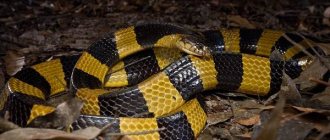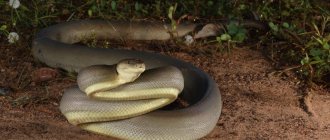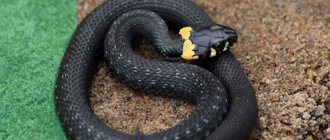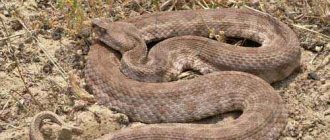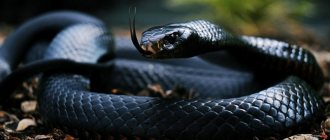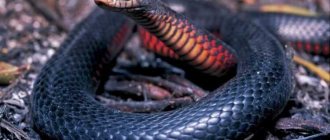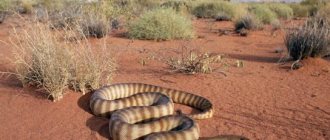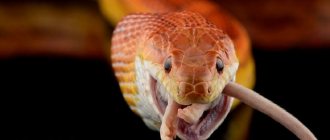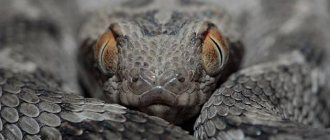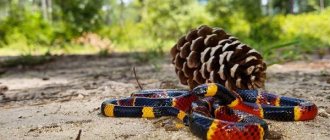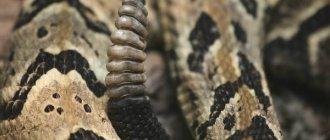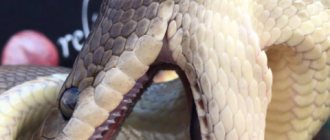Diet
The black echidna's diet mainly consists of frogs and other small vertebrates.
Adults also feed on reptiles and small mammals. These creatures can also hunt snakes.
The black echidna's diet also includes rodents. Therefore, when kept in captivity, they are fed mice.
Black echidna
- home
- Articles
- Encyclopedia of Animal Species
- Snakes
- Black echidna
- Content
- Classification
- Habitat
- Description
- Nutrition
- Reproduction
- Additionally
- Sources
- Captivity
BLACK ECHIDNA (Pseudechis porphyriacus) or black snake, distributed throughout Eastern and Southern Australia, reaches a length of 1.5-2 m. The shiny black color of the upper side of the body is effectively combined with the reddish color of the belly. The black snake lives in moderately damp low-lying areas and along river valleys, willingly goes into the water, swims and dives well. It feeds on frogs, lizards, and snakes. Juveniles prefer insects and other invertebrates. In captivity, the black snake eats mice well.
Classification Kingdom: Animalia (animals) Phylum: Chordata (chordates) Class: Reptilia (reptiles) Order: Squamata (squamate) Suborder: Serpentes (snakes) Family: Elipidae (slates) Genus: Pseudechis (echidnas) Species: Pseudechis porphyriacus (black echidna) )
Habitat Lives throughout Australia, mainly in the southern and eastern parts, as well as on the islands of New Guinea, with the exception of Tasmania and the north of the country. It prefers to settle near water areas, but can also live in damp lowlands. Favorite habitats are swamps and rivers. The black echidna is an excellent swimmer and diver who can spend a long time (up to 1 hour) under water without additional inhalation of air. It is most active during the daytime, when the water warms up well.
Description The black echidna is the largest poisonous snake in the world, as well as one of the most poisonous snakes in the tropical zone and is rightfully included in the list of the seven most dangerous snakes on the planet. In Australia, the black echidna is simply called "black snake" by locals. Until the mid-19th century, echidna was often mistakenly called a variety of poisonous snakes, including the common viper. In length it reaches an average of 1.5 - 2.0 meters, but individuals about three meters long have been recorded. The body and head of the black snake are colored shiny, bluish-black on top. The underside is pink to bright red with a black border. The scales of this species are smooth and symmetrical. Its body is thin, its head is small, narrow, covered with sparse brown spots, which are located near the eyes and on the nose of the snake. Paired poisonous teeth are located in the anterior part of the shortened maxillary bones; they are noticeably larger than the other teeth, curved back and equipped with a poison-conducting channel; fixed motionless (primitive feature). The venom-conducting channel in asps originates from a groove on the front surface of the tooth by gradually closing its edges. Usually only one of the poisonous teeth functions; the second is a “substitute” in case of loss of the first. In addition to fangs, the upper jaw has small teeth. If danger is suspected, the snake extends its neck above the ground to a height of 10-20 cm, tilts the front part of the body and at this time inflicts a bite. Its bite can potentially be fatal to humans; it almost holds the record for the amount of poison it secretes and produces. The neurotoxic poison it secretes can cause protein coagulation in the body. The black echidna is especially dangerous for swimmers because of its manner of lying motionless on the bottom of the river without showing signs of life. However, she only attacks if she is stepped on, shows open aggression, or tries to catch her. Deaths due to the bite of this snake are quite rare, despite the fact that in Australia many more people are bitten by this particular snake than are bitten by other snakes. The fact is that its poison, although produced in large quantities, does not have a strong effect, due to the fact that in case of defense the snake releases a smaller amount of poison than when hunting.
Diet The main diet of the black echidna consists of small vertebrates, mainly frogs. Juveniles of this species prefer to eat insects and other invertebrates, reptiles and small mammals. They can also eat snakes, including those of their own species. After the artificial introduction of aga toads covered with poisonous mucus into the ecosystem, a significant part of the population died. However, recently, there has been a significant increase in the number of these snakes. This happened due to the fact that black echidnas changed their nutritional priorities and began to give preference to rodents in their diet. In captivity, the black echidna also readily feeds on mice.
Reproduction During the mating period, males of this species enter into tournament fights among themselves for the female. They step on each other, arching their necks and raising their heads, trying to cover the opponent's head with their own. When one of them succeeds, he wraps his body around the opponent’s torso with a sharp movement. Furiously wriggling and hissing, they squeeze each other. After a while, as if on a signal, they stop the combat and crawl away to prepare for the next stage of the fight. Each of these “stages” lasts about a minute, and they are repeated until the males are completely exhausted. They can be so carried away by the tournament that they may not untangle themselves even if they are lifted from the ground. Typically, during the horizontal bar, snakes do not bite each other. In addition to sexual arousal, the reason for such fights is also the territorial instinct. The black echidna belongs to the so-called ovoviviparous snakes, like other adders. This means that she gives birth to already formed and viable cubs. Most often, as in the case of the black echidna, viviparity is simply the result of eggs retained in the female's oviducts. Those. eggs develop not in the ground, not in moss, not in a pile of dry leaves, like most snakes, but in the mother’s body. At the same time, a dense network of blood vessels develops in the snake’s oviducts and oxygen from the mother’s blood seeps into the egg, ensuring the baby’s breathing. It gets its nutrition from egg yolk. Zoologists call this phenomenon with the somewhat clumsy word “ovoviviparity.” Snakes that managed to master viviparity received a lot of advantages compared to other representatives of their suborder. First of all, their eggs are constantly under reliable protection. At the same time, the mother can calmly hunt, and not sit at the nest, tied, like a king cobra, which constantly guards the eggs. In addition, the snake can choose the most suitable places at any given time - well-warmed, which is especially important in the north, or cool, which is very important in tropical deserts. It is very difficult to find a place where favorable conditions are constantly maintained for a long time. The size of the cubs is on average about 15 - 22 cm in length. A female can give birth to from 8 to 40 cubs, however, due to high mortality, few survive to adulthood. The first molt occurs 10-11 days after birth.
Additionally, the venom of the black echidna does not have a significant effect on the walls of blood vessels and platelets, so coagulopathies in clinical practice in case of poisoning with venoms of Australian asps do not pose a particularly serious problem, although, in rare cases, the possibility of intracerebral hemorrhages exists and can cause death. Of the representatives of this group, the venom of this snake has the most powerful hemolytic effect. The venom in its general toxic effect resembles the effect of the venoms of sea snakes and kraits, but is very different from them in its composition. The action of presynaptic toxins is associated with phospholipase activity. Presynaptic polypeptides have a slower mechanism of action, but are more toxic than postsynaptic polypeptides. The use of serum better suppresses the effect of postsynaptic toxins. In case of poisoning with poisons containing strong presynaptic toxins, the use of serum practically does not slow down the development of paralytic symptoms, especially with delayed administration. After a bite, moderate local pain is felt at the site of introduction of the poison and in the area of regional lymph nodes, and slight swelling is observed. As a rule, there is a headache and vomiting (sometimes mixed with blood). Within an hour, neurological symptoms develop: darkening of the eyes, drowsiness, respiratory depression, bloody diarrhea, hematuria. There were no signs of paralysis or significant coagulation disorders. The black echidna differs from other representatives of the genus Pseudechis in some details of general morphology, the structure of the venom and blood proteins, and pholidosis. In addition, the onya is the only viviparous species in this genus of snakes. Notechis and Pseudechis serums are used to neutralize its poison. In neutralizing poison, Notechis serum is more effective than polyvalent Pseudechis serum, since the latter has a weaker effect and requires a larger volume of administration. The black echidna is one of the seven most dangerous snakes on the planet. Until the mid-19th century, a variety of poisonous snakes, including the common viper, were often called echidna.
Sources https://crenature.ru https://ours-nature.ru https://www.floranimal.ru https://www.mad-love.ru https://army.lv/ru https:// neobychno.com https://www.zooznaika.r
Keeping in Captivity Keeping this species in an artificial environment requires great care, given the snake's venomous nature. To create favorable conditions, they need a terrarium with a temperature of 22 - 28 degrees with shelters such as grottoes or wooden houses that create a darkened area and a bedding of large shavings. To maintain the required air humidity, it is necessary to spray water inside the terrarium 2-3 times a week. For feeding adults, rats aged approximately 7-9 days and laboratory mice are used. When feeding frogs, it is necessary to pay special attention to the place of capture, the species and their general condition, because snakes are very sensitive to toxins that can poison frogs (in particular, drugs for killing mosquitoes, which are used to treat many reservoirs). After the first molt, baby snakes, as a rule, can already feed on their own. They are fed to 2-3 day old laboratory mice, gradually increasing the age of the mice intended for feeding.
Health to you and your pets!
© 2022 ZOOVET Team We are always happy to help you! 24-hour consultation: +7 Make an appointment [email protected]
Return to list
How does reproduction occur?
This snake is viviparous, it does not lay eggs, but gives birth to viable children. This distinguishes this species from its peers, since the eggs of other snakes develop in nests.
This reptile chooses a place well warmed by the sun to give birth to its offspring.
The body of newborn cubs is about 20 centimeters. At one time, the female gives birth to from 8 to 40 children. Already 10 days after birth, the cubs molt.
Appearance and dimensions
The black echidna, or black snake as it is called in Australia, is a colorful member of the Aspid family. Representatives of this species are considered one of the largest among snakes:
- Adults can reach lengths of up to three meters. On average they grow from 1.5 m to 2 m;
- the body of the snake is quite massive, wide, but at the same time slender and flexible;
- the head is relatively small, short, slightly elongated, in the upper part it has a bluish-black tint, which has an extraordinary shine and radiance;
- there are light brown spots on the nose and near the eyes;
- the tail is long and flexible;
- the entire body of the reptile is covered with small smooth scales, on which the same shiny dark bluish color flaunts;
- below it is painted a noble red color.
On the upper jaw of the echidna you can see a pair of poisonous teeth, which differ from the rest in their large size.
In the middle of the teeth there is a channel through which the poison passes, and the teeth themselves are slightly curved in the middle. Most often, the snake uses only one poisonous tooth, the second serves as a spare one, in case the first one “does not work.” In addition to poisonous fangs, the reptile has many small non-poisonous teeth necessary for capturing prey.
Did you know? Until recently, almost all poisonous snakes, in particular the common viper, were called echidnas. Only from the middle of the 19th century did the black echidna receive official status.
Features of keeping in captivity
If a person chooses such a pet, one must be very careful, since this snake is poisonous.
To create favorable living conditions, she will need a terrarium with a temperature of at least 25 degrees.
It is also necessary to maintain optimal humidity by spraying water several times a week directly inside the terrarium. You need to feed your pet rats, mice or frogs.
Poisonous or not
The bite of a black echidna can in some cases be fatal to human health. In terms of the volume of poison secreted, this reptile occupies one of the leading places. Its venom is a strong neurotoxic substance that provokes protein coagulation in the human body. When attacking, the echidna extends its head to a length of 15–20 cm, tilts the front part of its body and instantly bites. Despite the fact that many cases of bites by this reptile have been recorded, deaths are quite rare. The thing is that when biting a person, it releases much less toxic substance than when hunting or killing an animal.
Important!
The black echidna is especially dangerous due to its habit of remaining motionless at the bottom of the reservoir. But at the same time, she attacks first only in case of defense, when she is shown aggression or when she is simply stepped on.
Photos of black snakes
Inland taipan / Oxyuranus microlepidotus
This dangerous snake hides in rocky crevices inside the mainland, and is dangerous because it has one of the most toxic poisons. If an antidote is not administered within 40 minutes after the bite, the person dies.
During a hunt, the Australian taipan injects a large amount of poison into the body of the victim, which instantly leads to death.
Interestingly, in the vastness of Australia there lives a harmless snake that has the same color and body structure as the poisonous taipan.
Nutrition
The echidna feeds on small insects. The main diet is ants and termites. The structure of the oral cavity allows the thin and sticky tongue to penetrate deep into the home of insects. Along with the food, stones and sand enter the animal’s stomach, which also participate in the digestion process. Together with the ants, the echidna receives all the necessary substances, including water.
In the absence of anthills and termite mounds, the echidna animal temporarily replaces them with other small insects and larvae from trees. The special structure of the sense organs helps to detect insects. Good hearing, sense of smell and the presence of electrolocation allow you to quickly detect a cluster of termites or ants.
The echidna's tongue is ideally suited for collecting and eating small bugs. It is capable of making up to 50 emissions in 30 seconds. This speed does not allow the nimble insects to leave the ruined house. In the case of a lack of nutrition, the echidna changes its habitat. To do this, it is capable of covering long distances on land and water. To search for food, the animal is not afraid to approach human settlements and farms.
The echidna's favorite food is ants, termites and other small invertebrates.
Mulga
A species of poisonous snakes from the asp family. They are also called brown kings. These snakes live in forests adjacent to deserts. The mulga has a powerful body and a wide head. It feeds on small reptiles, mammals and birds. Prefers to stalk prey by sitting in ambush. The mulga is considered the second most dangerous venomous snake to humans after the taipan. And although its venom is less toxic than that of many other Australian snakes, during a bite it injects it in very large volumes.
Blue tongue skink
This nimble, shiny lizard is the largest on the entire planet. The skink's body is covered with smooth, tight-fitting scales; it can reach 50 cm in length. The blue-tongued skink has five-fingered limbs, and its eyes are equipped with movable eyelids. It feeds on plant and animal foods. If the skink is disturbed, it opens its mouth wide and exhibits a blue tongue. Its bite can be painful, but is generally harmless to humans.
Literature
- Cogger, H. G. 2000. Reptiles and Amphibians of Australia, 6th ed. Ralph Curtis Publishing, Sanibel Island, 808 pp.
- Michael, D.R.; D. B. Lindenmayer; M. Crane; C. MacGregor; R. Montague-Drake; L. McBurney. 2011. Reptilia, Murray catchment, New South Wales, southeastern Australia. Check List 7(1):25-29
In another language section there is a more complete article Red-bellied black snake (English).
You can help the project by expanding the current article with translation.
Original: Original:
Geckos
An extensive family of small and medium-sized lizards. Their body is flat and short. A pair of huge eyes with narrow pupils, like those of a viper, clearly stands out on the muzzle. Geckos have short legs, and their feet are covered with many special hairs that help them stay on a completely smooth surface. Geckos love to live in houses. At night they run along walls and ceilings, hunting flies and other insects.
Share link
Blackish Hidden-Eyed Adder / Rhinoplocephalus nigrescens
This dangerous snake is distributed along the entire eastern coast of the mainland, and often approaches towns and cities.
Rhinoplocephalus nigrescens, growing no more than 50 cm, has a highly toxic poison. Therefore, when spotted indoors or encountered in the wild, extreme caution must be exercised.
She is nocturnal and, due to her black color, is almost invisible. But he has a rather peaceful disposition, and attacks people only in the most rare cases.
11
bearded dragon
This lizard got its name because of its characteristic neck pouch, which, in moments of aggression or excitement, swells, becoming like a prickly beard. Bearded dragons are terrestrial and active during daylight hours. They eat various invertebrates and small vertebrates, as well as plant foods: shoots, leaves and flowers of plants.
Amethyst python / Morelia amethistina
Let’s complete our review of dangerous snakes in Australia with a large python, which received such a beautiful species name because of its color. The peony is listed as an endangered species and is protected by law.
The largest individuals ever discovered in the vastness of the Green Continent reached a length of up to 6 m. It chooses secluded places to live, and spends most of its life in trees or in rocky folds of rocks.
Amethyst pythons feed on small mammals and birds, and often attack small kangaroos - wallabies.
If you are interested in the fauna of Australia, then you will be interested in reading our article on TopCafe about the most amazing spiders of the Australian continent.
?
